Another EURO 2020’s semi-final between England and Denmark was played at the Wembley Stadium. Before the game, both sides had huge expectations as they thought they had the qualities to win the battle. Although Mikkel Damsgaard scored a stunner from a direct free-kick to open the scoring, England managed to come back from behind with Harry Kane’s goal in the extra time.
But, what are the key tactical points from this game? Denmark did not look very bad until Kasper Hjumland took him off, this substitution directly gave England control of the game, the Danes had no way back. This tactical analysis will give an in-depth look into the tactics of Gareth Southgate and Hjumland in this exciting match.
Lineups
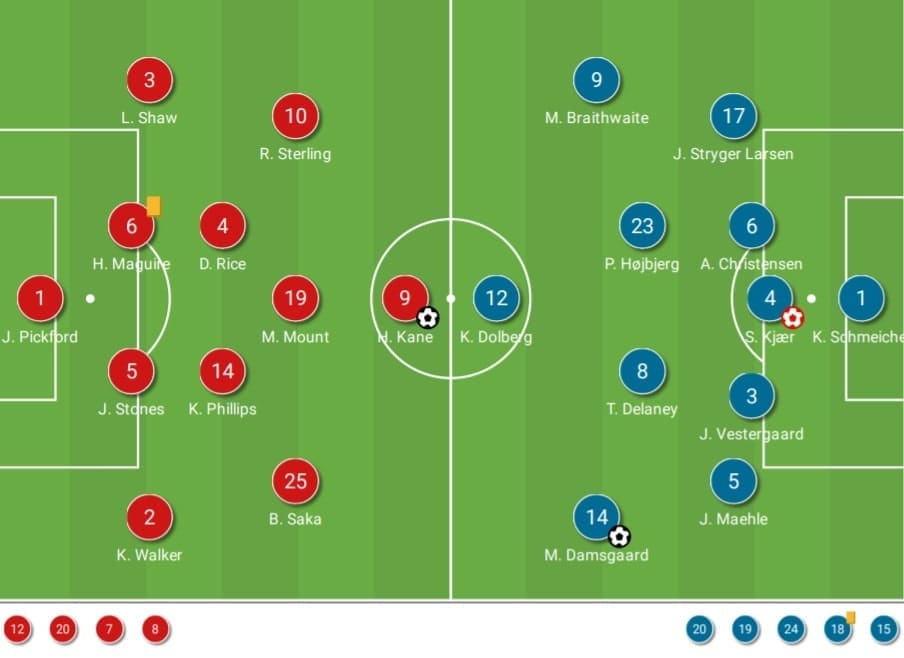
Apart from against specific opponents like Germany, England would stick with a back four system as they did in this game. Southgate already established a regular lineup with players he trusted the most, there might be one to two rotational or tactical considerations, but the likes of Declan Rice, Kalvin Phillips, Raheem Sterling, and the back four had already nailed the starting spots.
Denmark also had a regular starting team to play with one or two changes only. Daniel Wass and Yussuf Poulsen started on the bench because of the good performance by Jens Stryger Larsen and Kasper Dolberg. The team was in a good mood in general and they gave England a stern test.
Conservative England
Despite being criticized heavily for dropping the likes of Marcus Rashford, Jadon Sancho, and even Dominic Calvert-Lewin in the lineups, Southgate did not let the public opinions affect his tactics and decisions. He was clear about the key to win the cup ties was a solid defence instead of taking huge risks in the attacks to play beautifully. Hence, England continued to play with the conservative setups that brought them to this stage of EURO 2020.
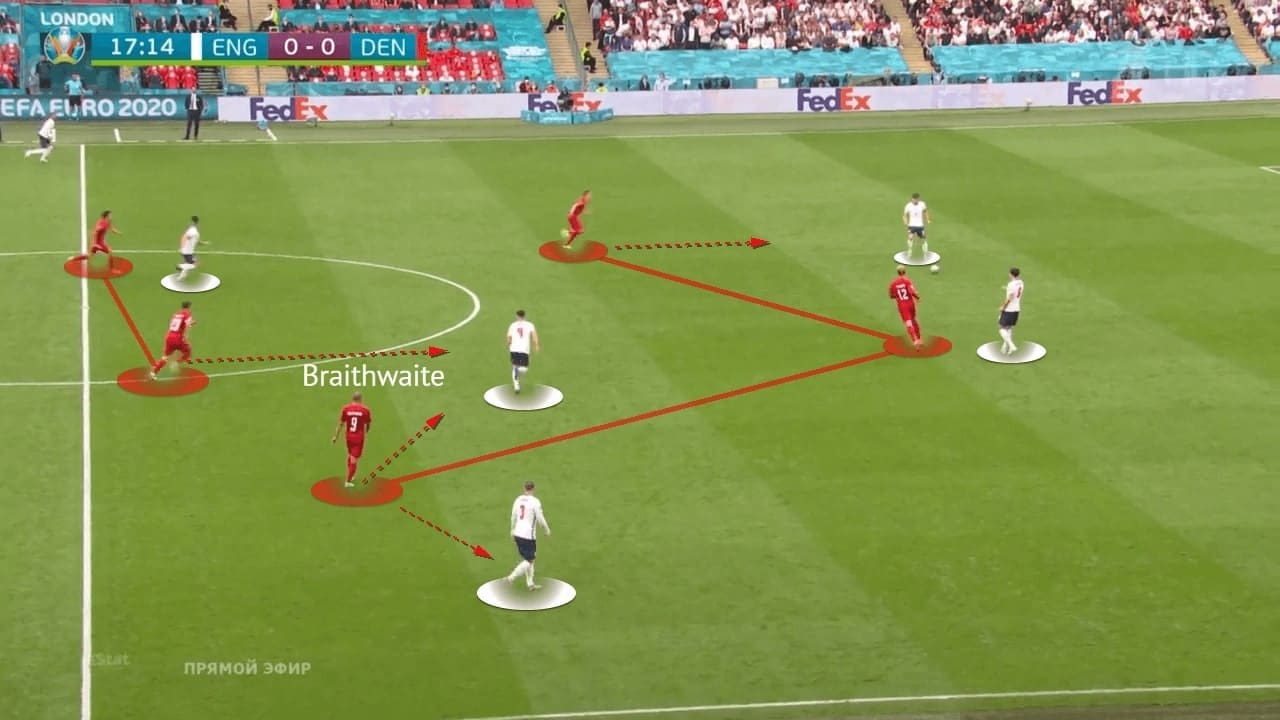
But Denmark were well-prepared to press England in this game. They defended in a 5-2-3 midblock while possessing numerical equality at the centre of the pitch. When they came out, the intensity of the press always forced England to play ineffective long balls, allowing the defenders to recover possession.
The above image shows Denmark’s pressing shape against England. Although it was a 5-2-3, the wingers needed to be flexible to tuck inside at the midfield as well. When one winger (Damsgaard in this case) pressed the England centre-back with Dolberg, the other must drop lower to balance the structure at the midfield as Martin Braithwaite did here. Only with this, the Danes could enjoy a 3v2 overload advantage, and the midfielders would not be pulled away from the centre-backs too much.
Of course, with a pair of low wing-backs, Denmark conceded the wide zones but England did not create huge threats through the full-backs either.
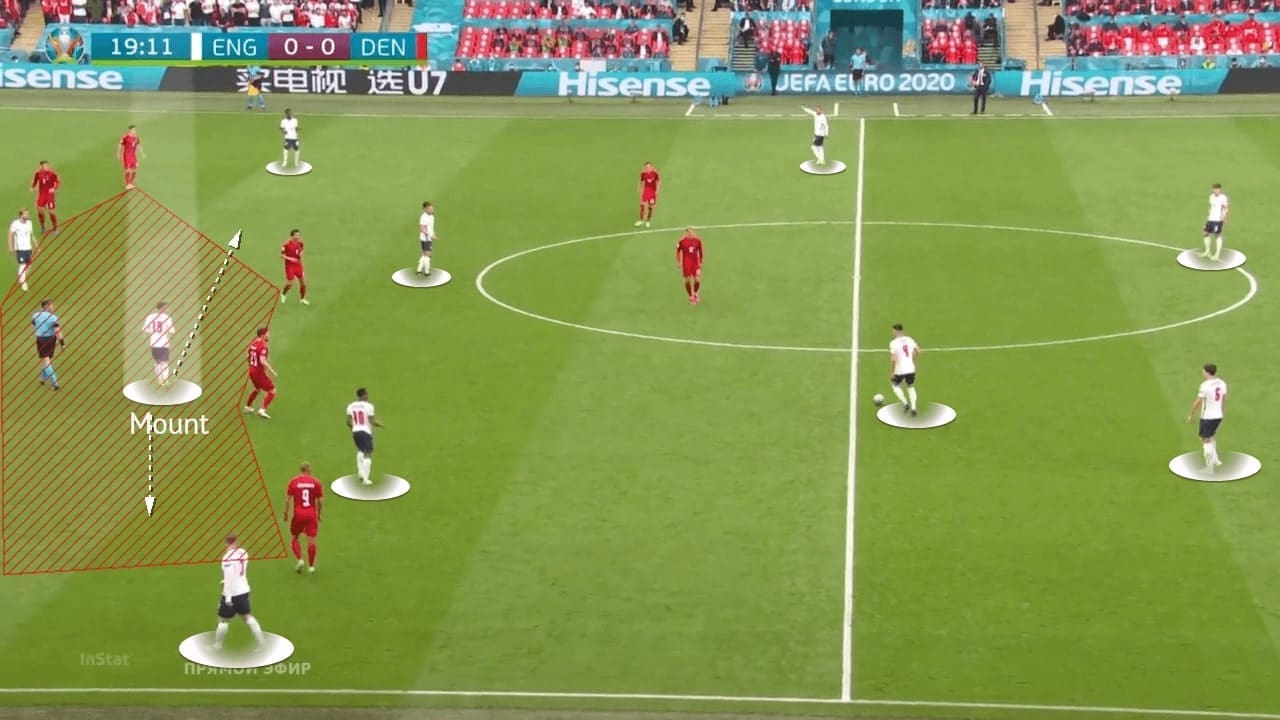
You would understand why England’s setups were a bit conservative through this image. They could not play like Italy because of lacking the occupation of spaces behind the midfield. Usually, Phillips and Rice were playing outside of the block, so the only player between the lines was Mason Mount. England struggled to connect the Chelsea youngster in the game as Denmark’s centre-backs were too good in this game, we will explain that a bit more later.
The positional structure of England could be flexible in a back four or a back three with Kyle Walker tucking inside. However, one thing Southgate would never give up was the domination at the centre of the pitch. He needed the presence of Rice in front of the centre-backs to suffocate all transition threats, alongside Phillips who might come deep as well. That’s why they were not very exposed to the competition.
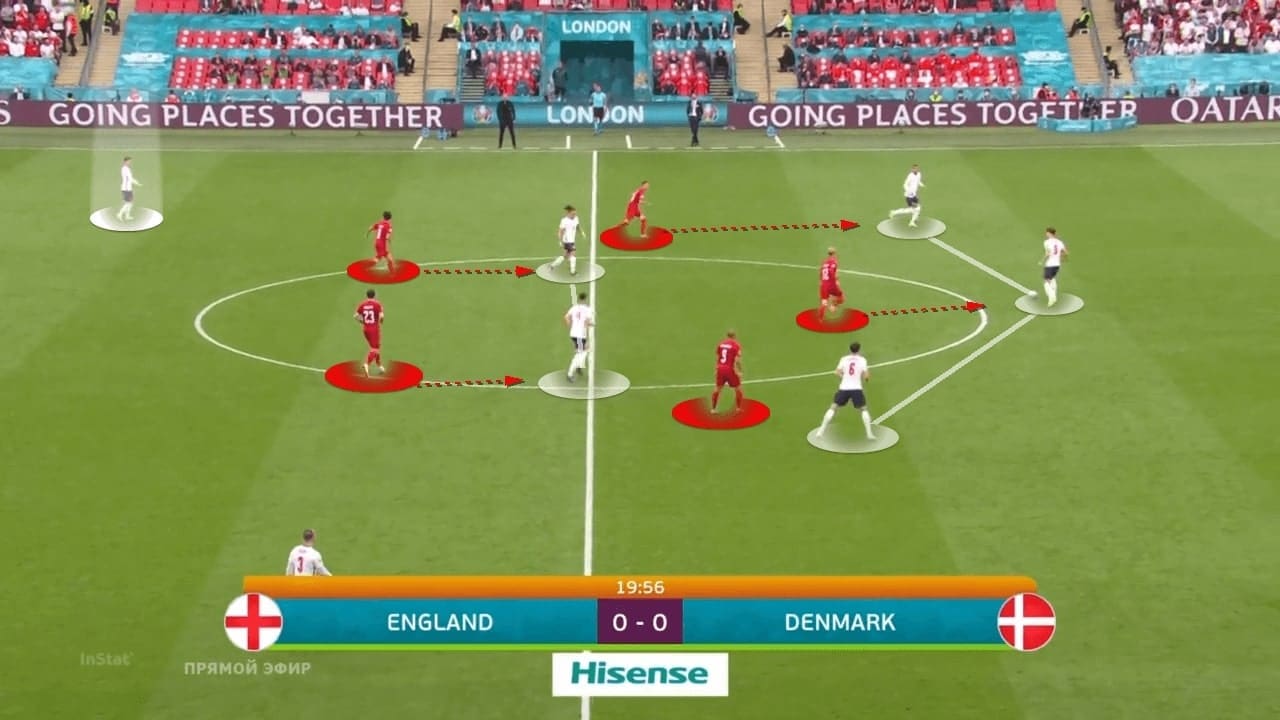
This example shows the struggle of England at the half-spaces. Again, we saw Denmark pressing in a 5-2-3/5-2-2-1 shape against England, they were very flexible to adjust the shape according to the position of Walker. Even the Manchester City right-back came inside to form a back three, England could not create a 3v2 overload at the first line as Damsgaard was always ready to press.
Apart from pressing the English defenders vertically, Denmark also had very tight control on the deep midfielders as Thomas Delaney and Pierre-Emile Højbjerg would always step up to press with the front players. They crowded the central spaces and England could not play through the centre.
But England could be flexible as well, they had Mount as the additional midfielder as the 6th man to create the “+1” advantage in this central 5v5. They also had Shaw who did not involve in the second phase enough as the free player as shown in this image.
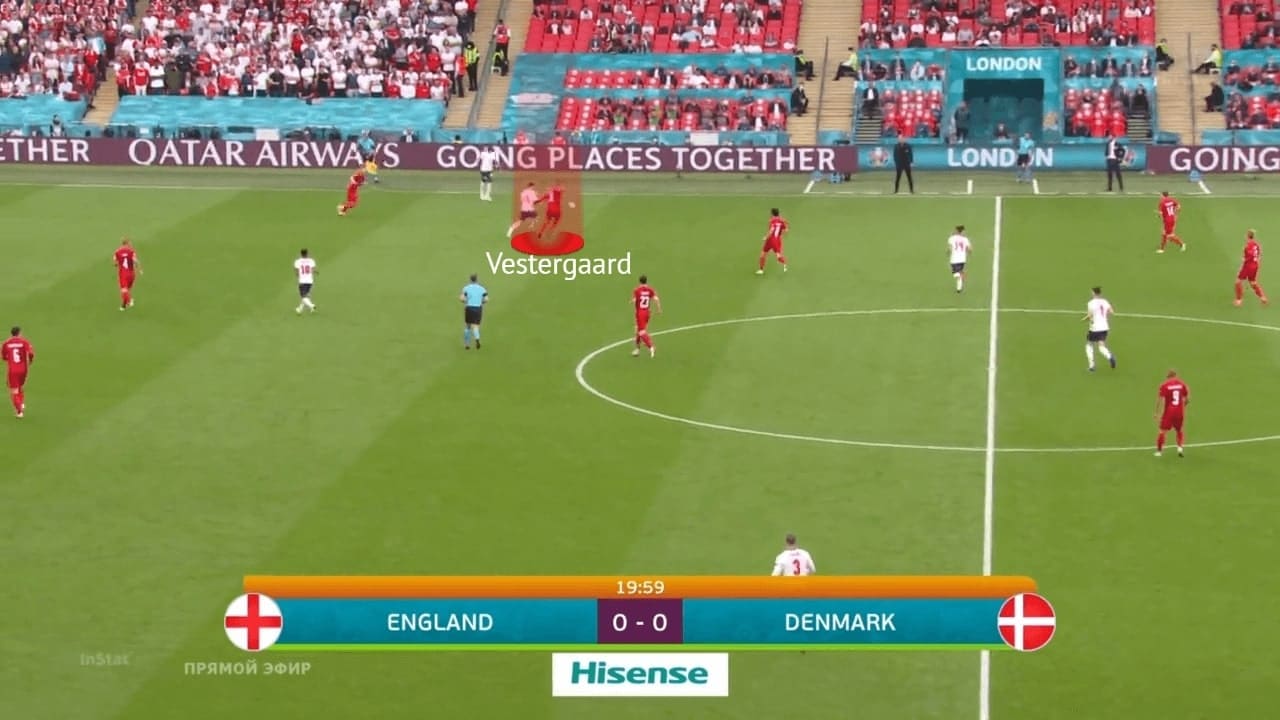
England’s centre-backs were quite strong at ball-playing, with the likes of Harry Maguire and John Stones could break the lines by passes in the second phase. They also broke the five-man press of Denmark in the previous example, finding Mount between the lines. However, Jannik Vestergaard was always a step ahead to intercept that pass from the centre-back position. England never really used that numerical advantage.
In the above image, Vestergaard took the ball away from Mount with his physicality and aggressiveness.
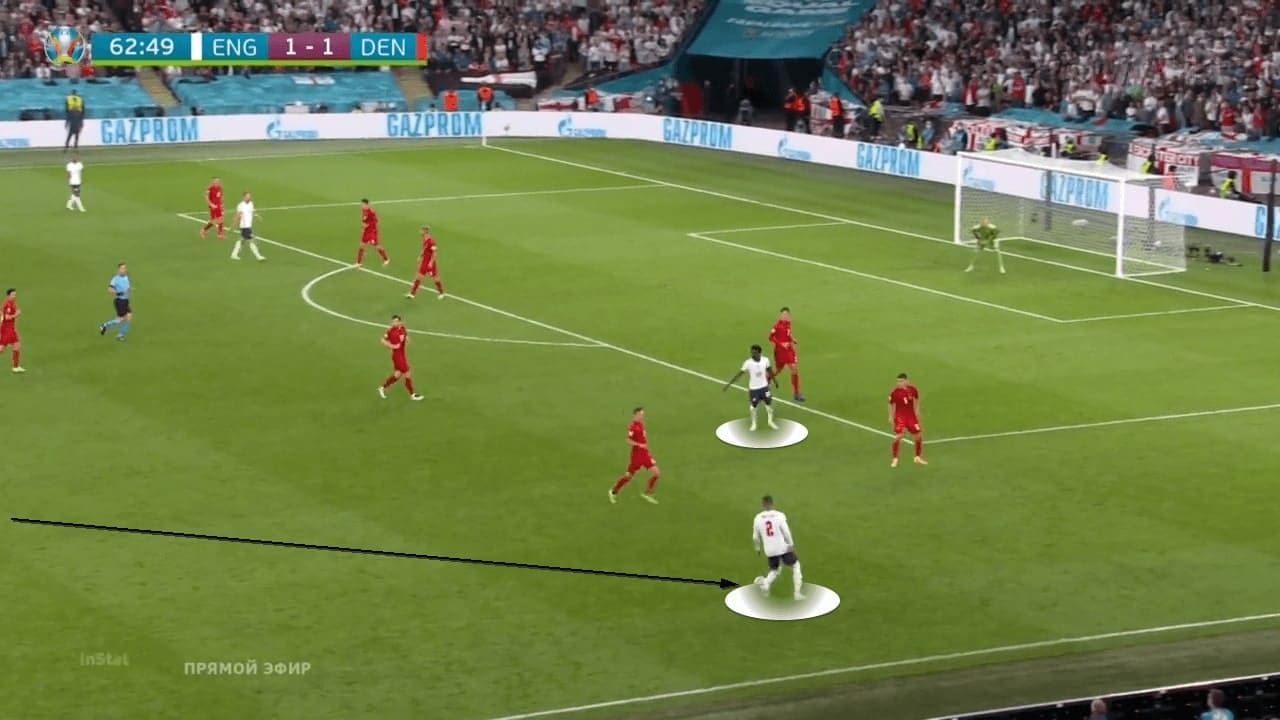
England were famous for the flank plays in this tournament because of their reluctance to get into the centre. However, they could not generate enough dynamics before the introduction of Grealish. With Bukayo Saka and Walker on the right flank, they did not have very clear qualitative superiority to give Joakim Mæhle troubles.
For example, even England switched and Walker received on the weaker side of Denmark, nothing could be created from here as he only had Saka around, while there was no one getting into the box or making diagonal runs to exploit the stretched defence of Denmark.
At flanks, England mainly utilized individual qualities liked the way Sterling won the penalty for the team. Or else they would need to wait for everyone going towards the ball to create a numerical superiority at the wide zones, allowing the likes of Sterling and Jack Grealish to play short passes into the penalty box.
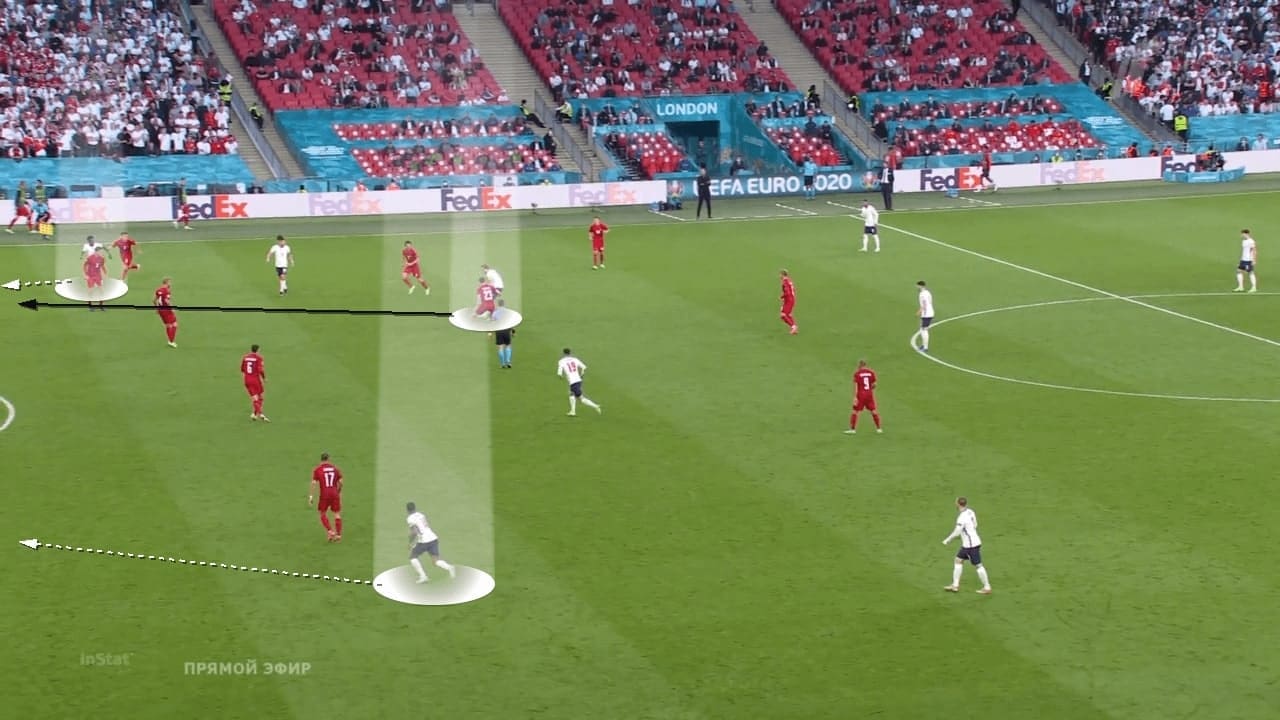
However, what made England a lethal team was the quality of Sterling in the final third. The Manchester City man was undroppable as he was the only one with the goal-scoring sense, pace, and movements to meet the chances. The leveller of England was a good example to remind people how special were the English players from an individual level.
Before the assist, Kane gave an extremely good pass to release Saka. That was down to his excellent body angle when receiving the ball, and his quick decision to hit the opposition. Meanwhile, Sterling totally outran Larsen in this attack as he knew the ball would come into the box in advance. This sense was his unique talent and the likes of Sancho, Rashford might not be providing the same to the team.
Denmark’s clever positional structure
Defensively, although England were conservative and limited the transition threats as much as possible, they were not good enough in the press. Denmark had a very good positional structure to exploit the press of England in this game.
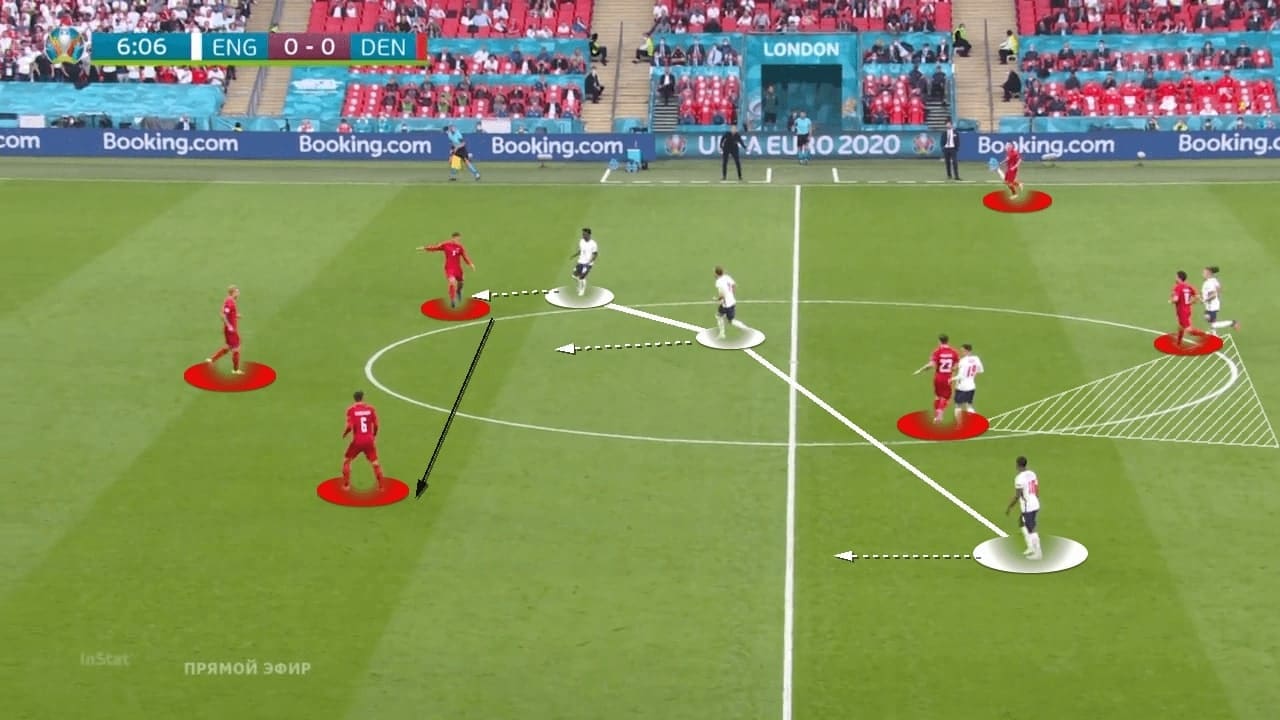
The first image gives the general setup of both teams. Denmark played with a 3-1 or a 3-2 shape with Simon Kjær staying a bit deeper to create depth for ball circulation. On the other hand, England pressed with a loose man-marking and using a pair of asymmetrical wingers in a 4-2-3-1/4-1-2-3 formation.
The intention of England’s press was a bit similar with Denmark, they needed a winger deeper to protect the central zone, so you could see the front three were positioning themselves at different heights in this screenshot. Although they had man-markers to lock Højbjerg and Delaney, the issue was being late on the wide centre-backs after switches. As Sterling was deeper initially in terms of positioning, he could not close the angle of Andreas Christensen, so Denmark could use the Chelsea centre-back to develop the attack.
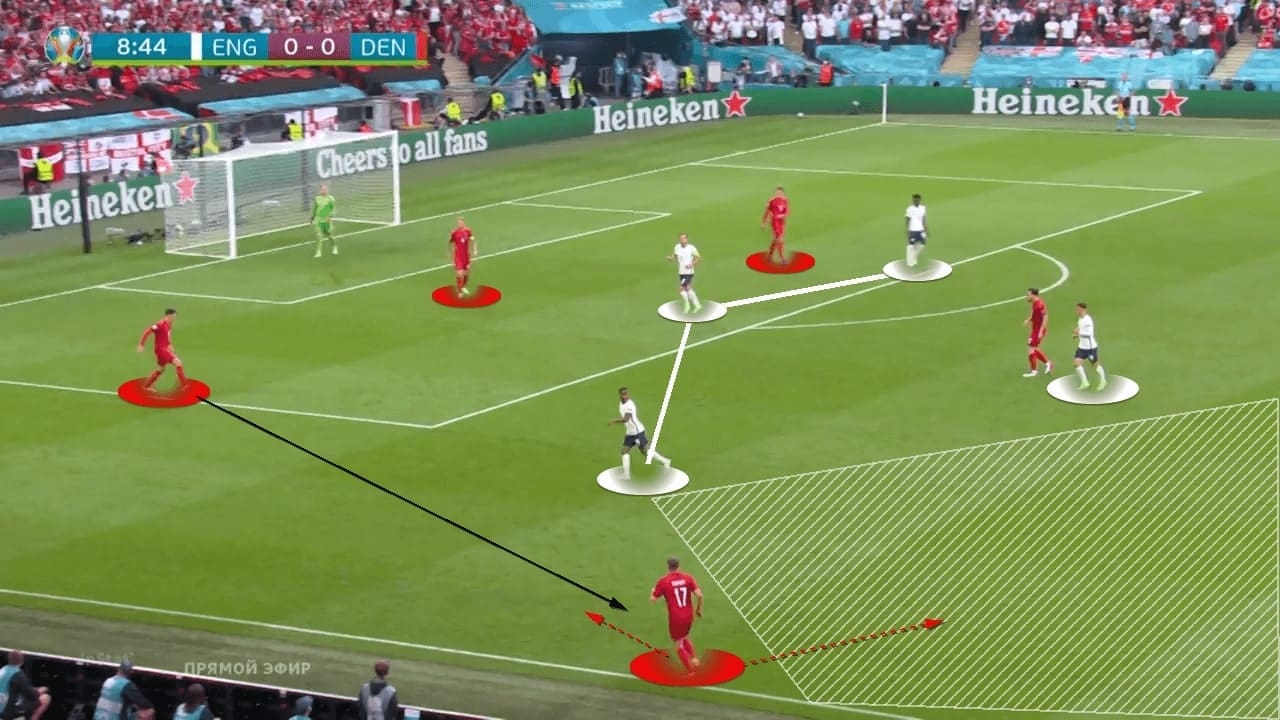
The situation was a bit more complex when England were pressing high as the dilemma was how to shut the Denmark wing-backs in the build-up. It took some minutes for Southgate’s men to adapt.
Here, England used the same scheme – pressing with an asymmetrical front three, man-marking on midfielders at the centre. However, Sterling faced a problem here: if he pressed Christensen vertically, Larsen would be free to receive unless Shaw was up. So you could see the Manchester City winger was checking the position of Shaw in this screenshot.
But…… if Sterling stayed around Larsen, Christensen would be the free player in the build-up, England’s press was in vain.
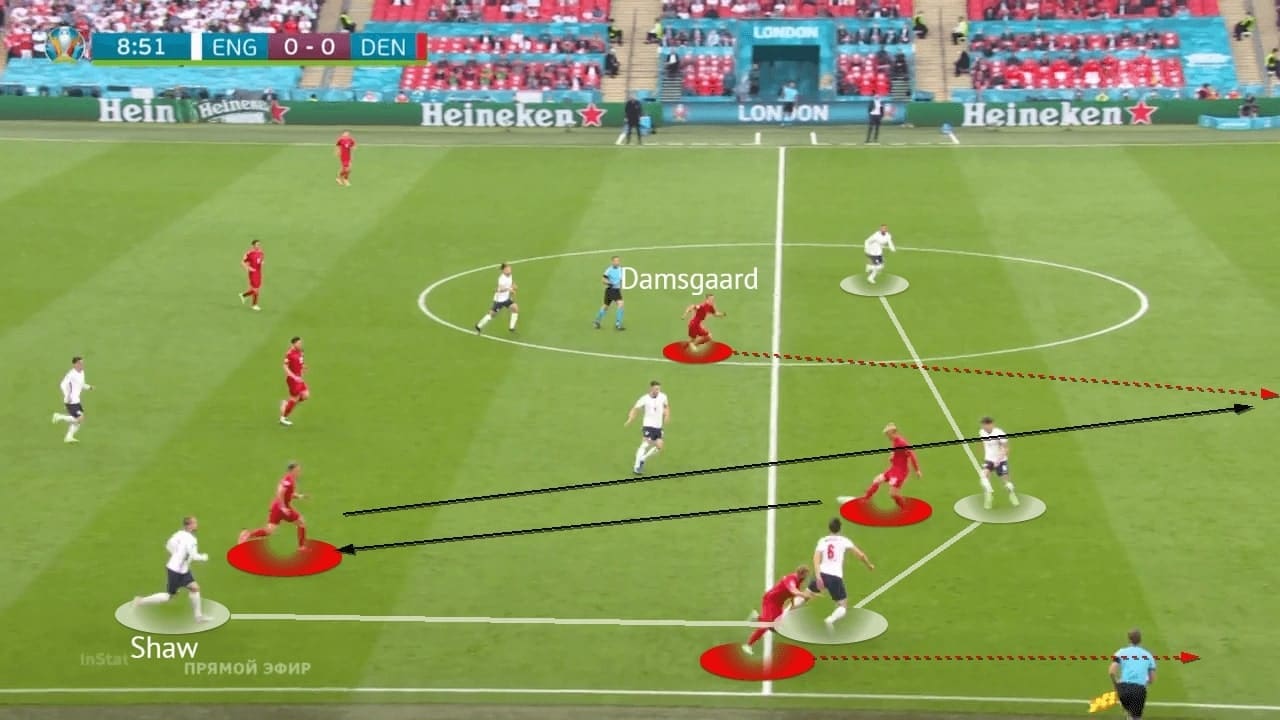
Because of confusion in the previous example, Sterling could not stop Denmark from playing out from the back. Christensen played the ball to Larsen and England could only react, that’s why they were all late to press the oppositions.
This was actually a favourable situation for Denmark to create a goal-scoring opportunity. As Shaw was very late to press Larsen, England could stop the Danes but the backline was imbalanced. When shifting, gaps was opened between Stones and Walker, it was very risky as Southgate’s team could only rely on the pace of Walker to track the Sampdoria youngster.
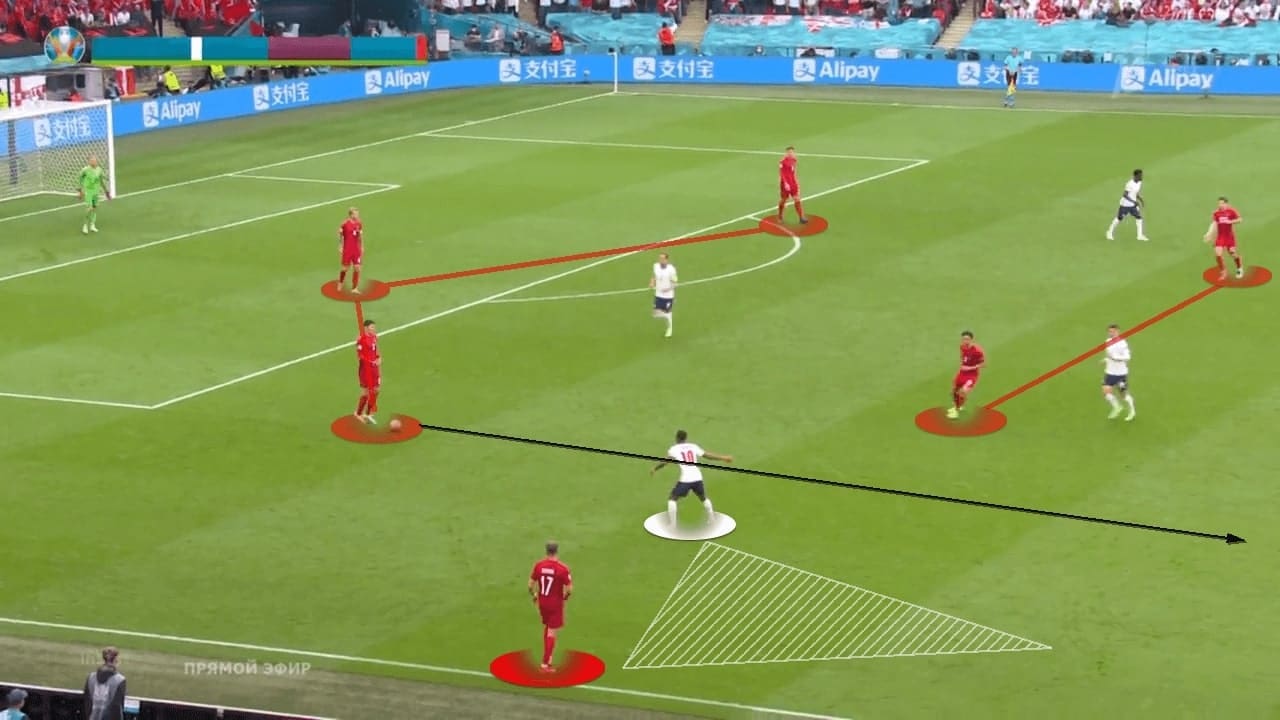
In another example that happened a few minutes later, we saw England adapted to the structure of Denmark and they looked a bit better. The situation was more or less the same: 3-2 build-up shape of Denmark, Larsen staying deep to help, England’s man-marking at the midfield, front three to press.
But Sterling’s decision was different this time, he stayed a bit wider to shut the wide zone, limiting the spaces for Larsen to receive from Christensen. Instead of blocking the half-spaces, he was showing Christensen the way vertical channel, asking Shaw to pay attention to the upcoming pass (see his gesture).
Also, note that Saka on the far-side was jogging behind……
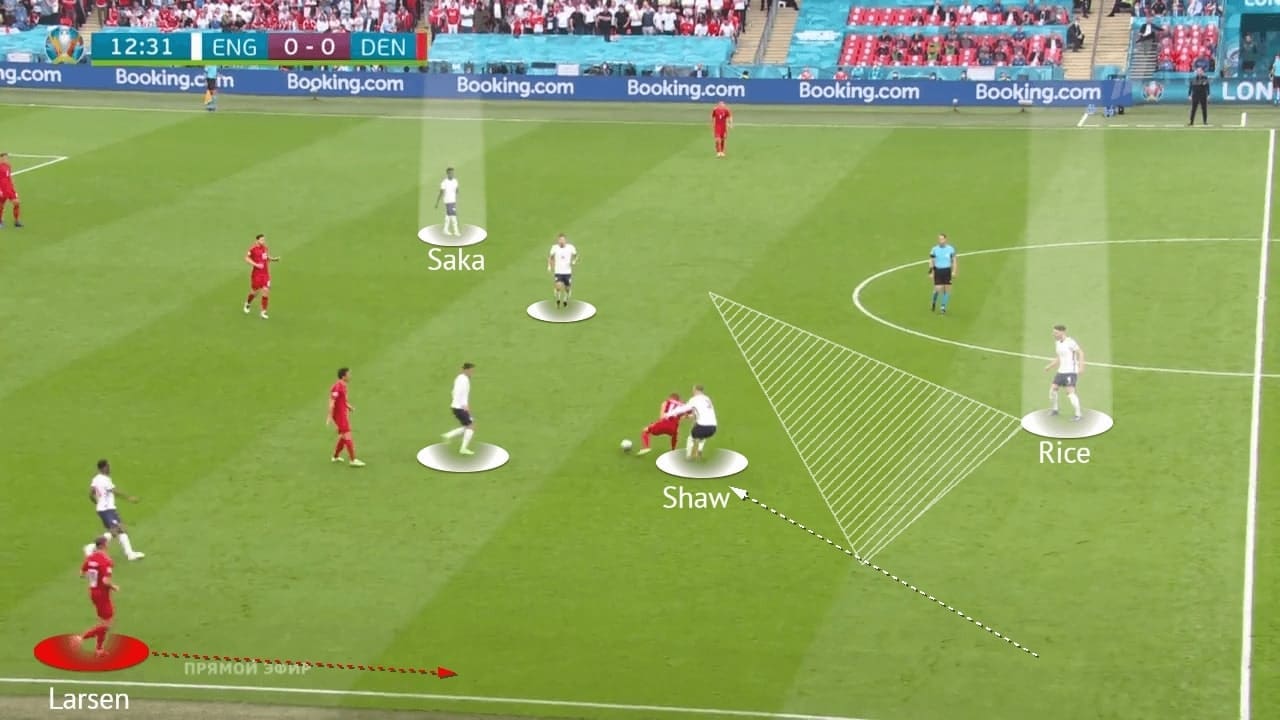
…… this turned out to be a successful press from England as things were more controllable. When Damsgaard came deep to receive the vertical pass of Christensen, Shaw stuck with him tightly and diagonally to push him inside. The only instant threat of Denmark was Larsen at the flank but Damsgaard could not play to him under pressure.
When Damsgaard was trapped inside, you could see how many English players were dictating the centre of the pitch. That is why Saka was jogging back, as his presence would also add a man at the midfield, while the loose marking of Phillips could give him some flexibility to defend spaces. And do not forget England had West Ham’s midfielder – Rice to cover everyone at the midfield.
Without Damsgaard, Denmark collapsed
In the second half, situations were quite similar to the first 45 until Hjumland took Damsgaard off and switched the formation, a decision which he might regret.
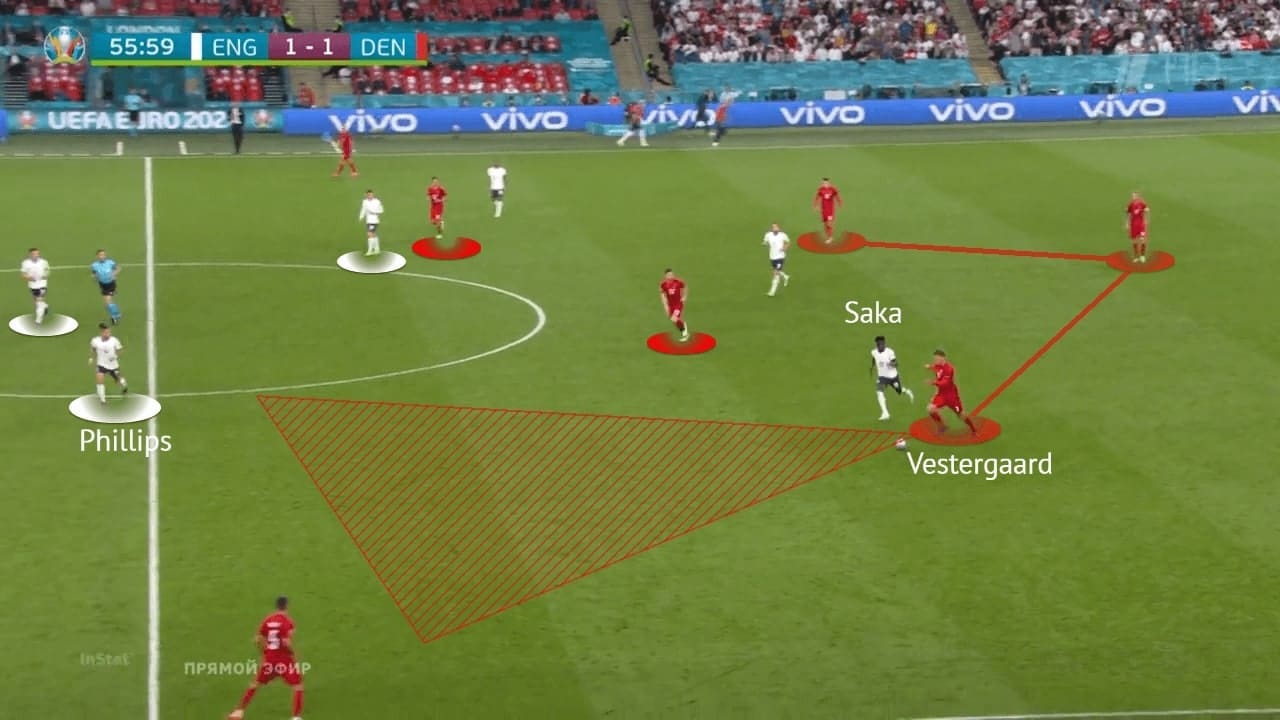
In the build-up, it was the same in Denmark’s setups against England’s press, now Phillips had greater freedom to defend with Rice at spaces deeper. He gave up the man-marking at the midfield and focused on covering spaces more as you saw Højbjerg was free in this image.
But England’s struggle was giving the wide centre-backs of Denmark too many rooms to play. Here, Vestergaard had big spaces to carry the ball forward, even Saka would not stop him from progressing.
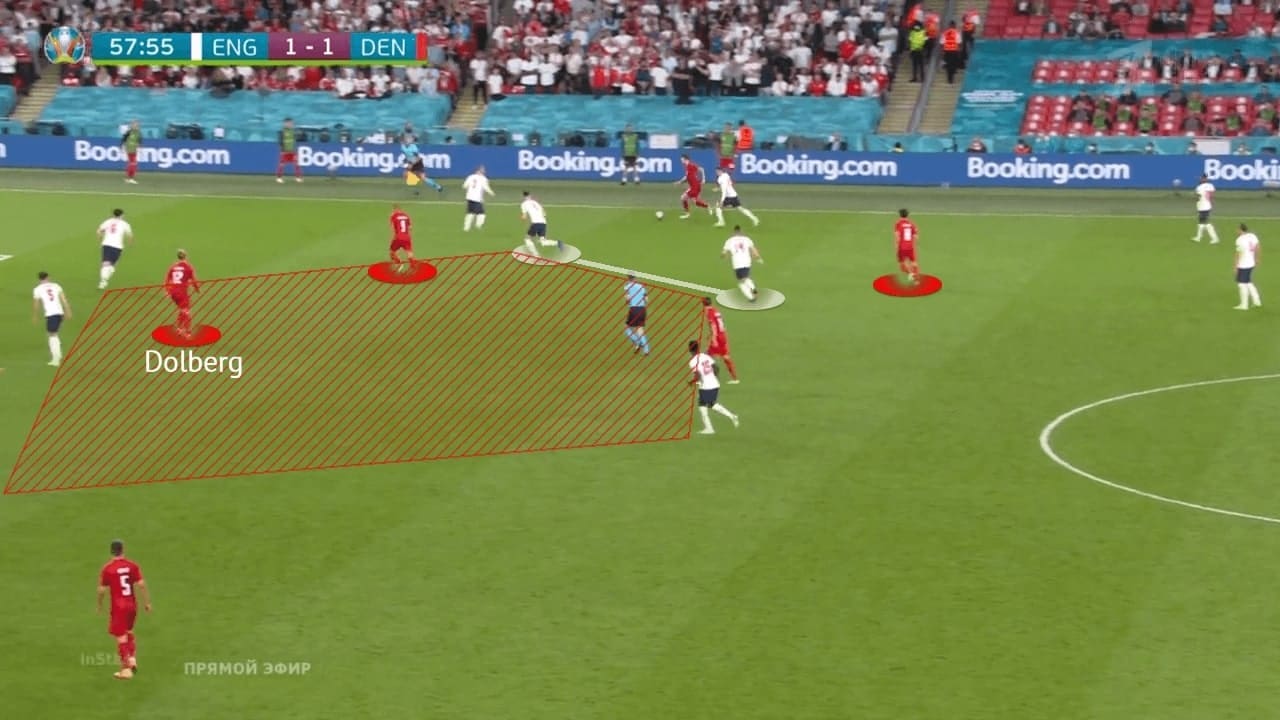
In the final third, Denmark tried to draw Phillips and Rice out of position and exploit the central spaces. When they attacked from the flank, on some occasions they could take Phillips away from the middle as shown in the above image. Then, the likes of Dolberg or Braithwaite could have 1v1 momentums against the defenders, but they did not possess huge qualities to create troubles in these situations.
Apart from playing into zone 14, they could also attack the penalty box by the deep runs of Delaney and crossing.
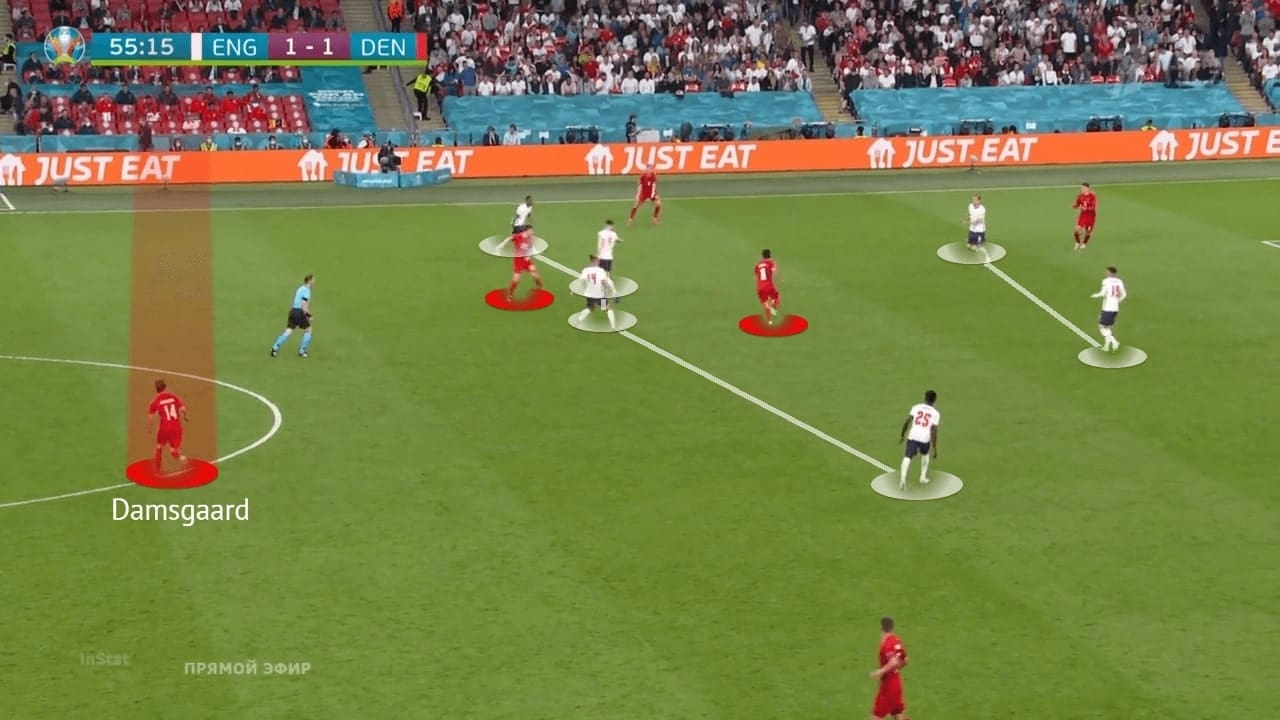
And here was why Denmark should not take Damsgaard off and add another midfielder. When Damsgaard was playing, he made good decisions on going up and down to find the best spaces.
For example, when England were pressing with six men, Rice was drawn out of position, Damsgaard was just patiently waiting for the ball behind the midfield. That means Denmark did not need an extra midfielder in the build-up actually, it killed spaces at the centre and made England easier to defend.
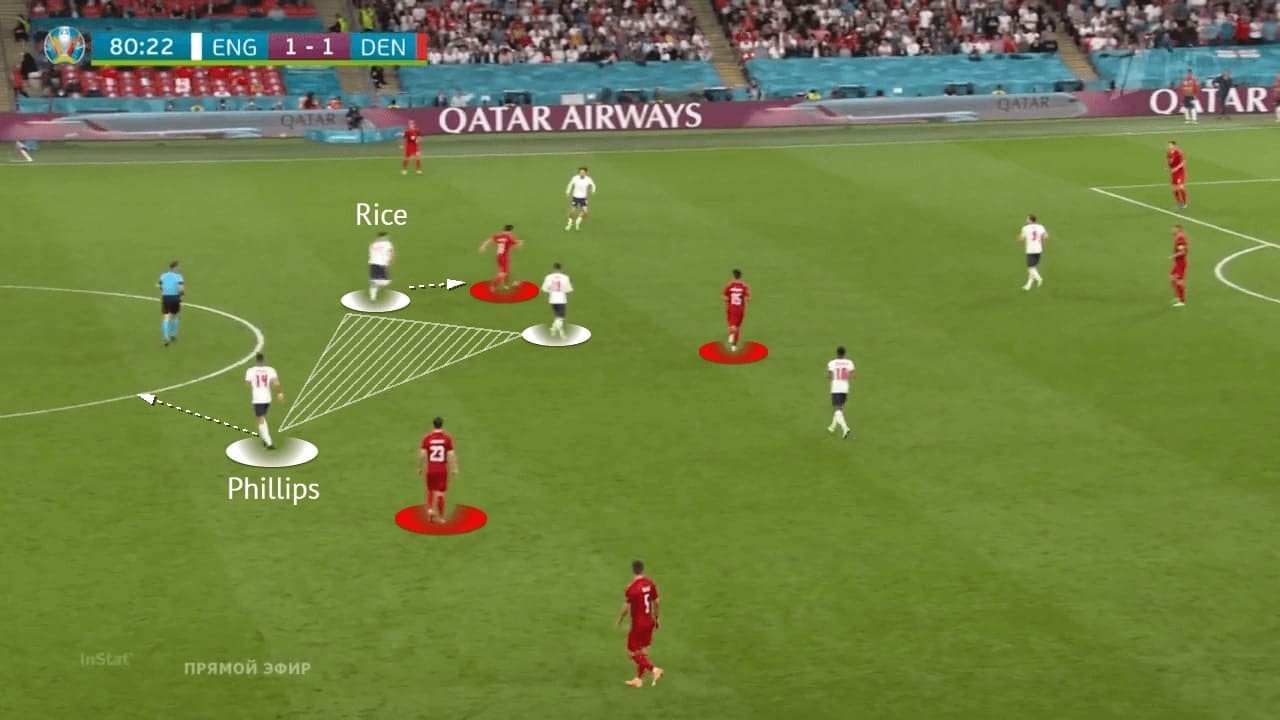
This was the situation without Damsgaard, now Christian Nørgaard also played at the midfield but all three midfielders of Denmark were too close to each other. Even Phillips could free himself to get behind and cover spaces behind Rice as he knew the passing lane to Højbjerg was blocked already.
Also, when they had Poulsen controlling the long balls high up on the pitch, without Damsgaard around, the RB Leipzig striker did not have enough support as well.
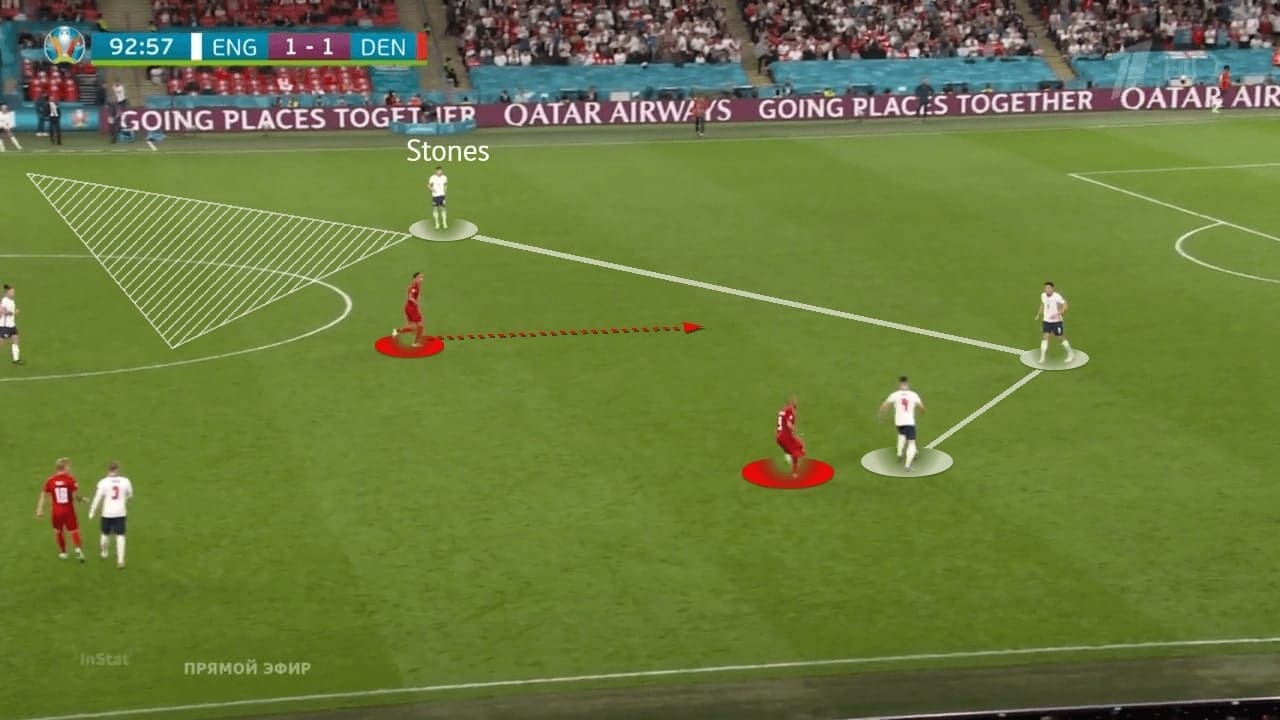
The change also adversely affected the defending of Denmark, now they could not press England. Without Damsgaard to provide the energy and intensity in the press, they could not flexibly shift between a 5-2-3 and a 5-3-2 to press the back three vertically. They gave England too much time and space to find the rhythm in the attack, and gradually dropping deeper and deeper, until Kane found the back of the net.
Here, Rice dropped to form a back three for England, Denmark had no response and no control on Stones as they had two strikers only. The 3v2 numerical advantage of Southgate’s men was clear, from there, England constructed many fruitful attacks on the right side. Denmark had huge troubles coping with the pace of Sterling and Phil Foden, as well as the overlapping runs from wide players.
Final remarks
Is football coming home? We still don’t know yet, at least Southgate and his troops had one more game to go, they must beat Roberto Mancini’s Italy to win the trophy. So far, they showed their conservative, but the tough approach was a great help to the defence, the record of conceding one goal before the final was very good. However, the pressing was imperfect structurally, England would have to be very careful at handling the Italian side that was very good on the ball.
Although the analysis pointed out Hjumland’s decision to sub Damsgaard off might be the decisive reason for their loss, he should still be given huge credits for the work throughout the tournament. With a star player missing in the squad, Denmark showed incredible team spirits and mentality to enter the semi-final – one of the best results in history. They still have very young and promising talents, and we should expect the Danes to continue flourishing in the future!





Comments